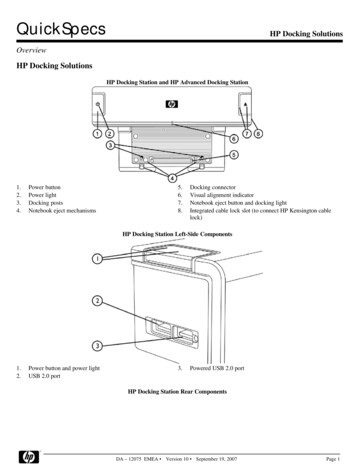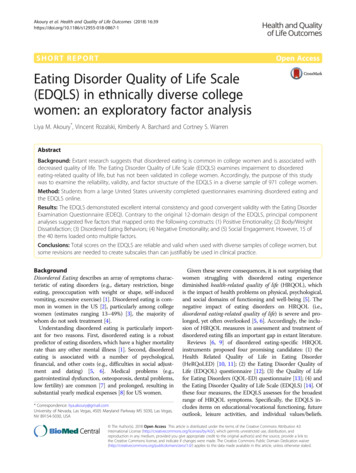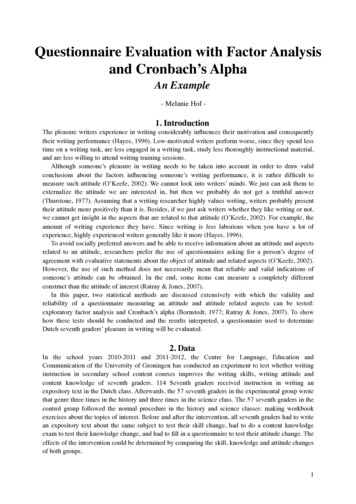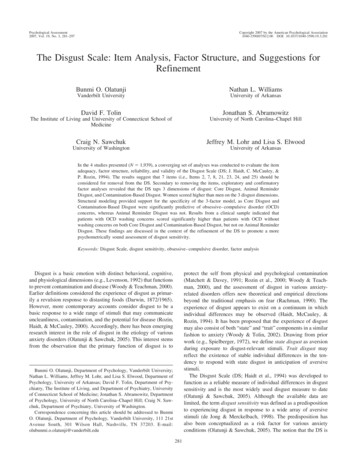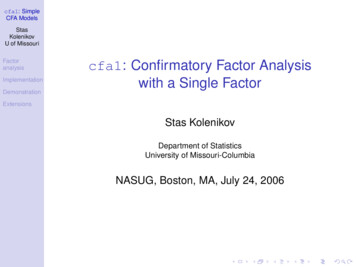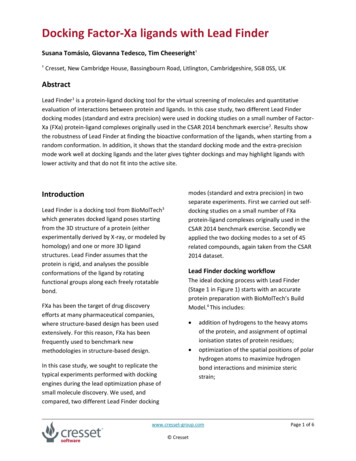
Transcription
Docking Factor-Xa ligands with Lead FinderSusana Tomásio, Giovanna Tedesco, Tim Cheeseright††Cresset, New Cambridge House, Bassingbourn Road, Litlington, Cambridgeshire, SG8 0SS, UKAbstractLead Finder1 is a protein-ligand docking tool for the virtual screening of molecules and quantitativeevaluation of interactions between protein and ligands. In this case study, two different Lead Finderdocking modes (standard and extra precision) were used in docking studies on a small number of FactorXa (FXa) protein-ligand complexes originally used in the CSAR 2014 benchmark exercise2. Results showthe robustness of Lead Finder at finding the bioactive conformation of the ligands, when starting from arandom conformation. In addition, it shows that the standard docking mode and the extra-precisionmode work well at docking ligands and the later gives tighter dockings and may highlight ligands withlower activity and that do not fit into the active site.IntroductionLead Finder is a docking tool from BioMolTech3which generates docked ligand poses startingfrom the 3D structure of a protein (eitherexperimentally derived by X-ray, or modeled byhomology) and one or more 3D ligandstructures. Lead Finder assumes that theprotein is rigid, and analyses the possibleconformations of the ligand by rotatingfunctional groups along each freely rotatablebond.FXa has been the target of drug discoveryefforts at many pharmaceutical companies,where structure-based design has been usedextensively. For this reason, FXa has beenfrequently used to benchmark newmethodologies in structure-based design.modes (standard and extra precision) in twoseparate experiments. First we carried out selfdocking studies on a small number of FXaprotein-ligand complexes originally used in theCSAR 2014 benchmark exercise. Secondly weapplied the two docking modes to a set of 45related compounds, again taken from the CSAR2014 dataset.Lead Finder docking workflowThe ideal docking process with Lead Finder(Stage 1 in Figure 1) starts with an accurateprotein preparation with BioMolTech’s BuildModel.4 This includes: In this case study, we sought to replicate thetypical experiments performed with dockingengines during the lead optimization phase ofsmall molecule discovery. We used, andcompared, two different Lead Finder dockingaddition of hydrogens to the heavy atomsof the protein, and assignment of optimalionisation states of protein residues;optimization of the spatial positions of polarhydrogen atoms to maximize hydrogenbond interactions and minimize stericstrain;www.cresset-group.com CressetPage 1 of 6
algorithms to increase accuracy and reliability ofpredictions at the cost of slightly slower speedof processing.optimization of side chain orientations ofHis, Asn and Gln residues for which X-rayanalysis can return flipped orientations dueto apparent symmetry.Figure 1. A typical Lead Finder workflow.Scoring functions1 in Lead Finder (Stage 4) arebased on a semi-empiric molecular mechanicalfunctional that explicitly accounts for varioustypes of molecular interactions. Individualenergy contributions are scaled with empiriccoefficients to produce three scoring functionstailored for:Build Model uses an original graph-theoreticalapproach5 to assign optimal ionization states ofprotein residues at arbitrary pH conditions,which is based on the Screened CoulombPotential (SCP) model.5,6After completing protein preparation, an energygrid map (Stage 2) is calculated and saved forthe protein binding site. This energy map is thenused to dock the ligand structures. The docking engine in Lead Finder (Stage 3)combines a genetic algorithm search with localoptimization procedures, which make LeadFinder efficient in coarse sampling of ligandsposes and following refinement of promisingsolutions. correct energy-ranking of docked ligandposes (Rank-score);correct rank-ordering of active andinactive compounds in virtual screeningexperiments (VS-score);binding energy predictions (dG-score).In this study we concentrated on the poses thatwere generated and hence were focused on theRank-score function.The standard docking mode provides anaccurate and exhaustive search algorithm.However, in extra-precision mode, Lead Finderuses the most rigorous sampling and scoringwww.cresset-group.com CressetPage 2 of 6
Protein-ligand dockingMethodInitially we used a crystal structure of the FXaprotein in complex with compound GCT000006(GCT, PDB ID: 4ZH8). As can be seen in Figure 2,the 6-chloronapth-2-yl group of GCT binds intothe S1 primary specificity pocket, while themorpholino group occupies the aromatic box(Tyr99, Try215, Phe174) of the S4 pocket.A sub-set of 45 small molecules from the CSAR2014 dataset with known activity against FXaTable 1. Representative structures for 45ligands used in the docking study.Phenyl SubstitutionActivity(pIC50)7.38.2Figure 2. Structure of the FXa protein incomplex with the GCT ligand.The protein was prepared with the defaultoptions of Build Model, in which the ligand isremoved from the active site and the watermolecules are retained. The coordinates of theligand were then used to define the boundingbox for the calculation of the energy grid maps.6.47.6Self-docking experimentWe started by re-docking GCT to the 4ZH8crystal structure to address the ability of LeadFinder of correctly identifying its bioactiveconformation. In order to avoid bias in the selfdocking experiment, the 3D conformation ofGCT was flattened to 2D and then convertedback into 3D using Cresset’s XedConvert7. Aminimization with Cresset’s XedMin7 wasfollowed to relax the ligand to a local minimum.The GCT ligand was then docked to the proteinPDB 4ZH8 using the standard docking mode andthe extra-precision docking mode.7.87.86.2www.cresset-group.com CressetPage 3 of 6
Figure 3. Lead Finder self-docking experiment on 4ZH8 using the standard (top row) and extraprecision (bottom row) docking modes. The RMSD (in Å) between the docked pose (thick sticks) andthe X-ray coordinates of GCT (thin sticks) is reported for each pose.(Table 1) were docked to the crystal structure4ZH8.docking modes. The poses are ordered from thebest ranking (left) to the worst ranking (right).Most of these ligands have in common achlorinated mono or polyaromatic group and amorpholino group. All ligands were convertedinto 2D and then back to 3D with XedConvertand subsequently minimized with XedMin. Thecrystallographic ligand was used to define thebounding box for the energy grid maps. The 45ligands were then docked to the protein usingthe standard docking mode and the extraprecision mode.As can be seen in this picture, the five topranking poses for both standard docking modeand extra-precision mode are closely aligned tothe X-ray conformation of the ligand, correctlyorienting the naphthalene ring of GCT into theS1 binding pocket.ResultsSelf-dockingWhen using the standard docking mode and theextra-precision mode, Lead Finder outputs up to10 best poses (if available) ranked in order ofincreasing rank score.In terms of RMSD deviation, values obtained aresimilar with the two different modes with eachmethod able to find a solution within 2A RMSDof the x-ray pose in the top 5 results. However,the extra precision mode finds this result atposition 2 rather than 4 and the pose is veryclose to the xray-ligand (RMSD 1.44) with asingle R-group oriented differently. A small butpotentially significant improvement.Figure 3 shows the five top ranking poses ofGCT obtained using the Lead Finder standard(top row) and extra precision (bottom row)www.cresset-group.com CressetPage 4 of 6
Figure 4. Self-docking experiment on 4ZHA, 4Y7A and 4Y79 using Lead Finder’s extra-precisionmode. The RMSD (in Å) between the top-scoring docked pose (thick sticks) and the X-raycoordinates of the native ligand (thin sticks) is reported for each pose.Figure 4 shows the self-docking of other FXaproteins (4ZHA, 4Y7A and 4Y79) performed withthe standard docking mode and with the extraprecision mode.For these less flexible ligands, the extraprecision mode seems to have little effect onthe RMSD of the results. Both modes are againable to identify the correct orientation of theligand in the FXa active site with a RMSD that iswithin 2A for the top scoring pose.Protein-ligand-dockingFigure 5 shows a side-by-side comparison of thesuperimposed top-ranking poses for the 45 FXaligands docked into the 4ZH8 protein usingstandard (left) and extra precision (right)docking modes.For the standard mode, the majority of ligandsare docked with the naphthalene ring correctlypointing down into the S1 binding site.However, one ligand is not docked as expected,with the pyrrolidine group pointing to theFigure 5. Docking FXa ligands to 4ZH8 using the Lead Finder’s standard (left) and extra precision(right) docking modes.www.cresset-group.com CressetPage 5 of 6
outside of the protein (GCT98A). Interestingly,this compound is the one with the lowestactivity (pIC50 6.2) in the dataset.When using the extra-precision mode, thedocked poses in general look tidier, eventhough two ligands docked with thenaphthalene group pointing outside of the S1pocket: one is again GCT98A, and the other isGCT44A, the compound in the dataset with thesecond lowest activity (pIC50 6.4). Thesefindings seem to indicate that Lead Finder maybe able to provide useful suggestions fordiscriminating between active and non-activecompounds.standard and extra-precision) to dock a sub-setof FXa ligands from CSAR 2014. While bothmethods seem to work well at generatingsensibly aligned poses, the extra-precisionmode provides tighter dockings and may beable to highlight ligands with lower activitywhich may not fit into the active site.ConclusionThis case study shows a typical Lead Finderdocking workflow and demonstrates therobustness of the program by means of severalself-docking experiments. Results show thatLead Finder does a good job at finding thebioactive conformation of flexible ligands, whenstarted from a random conformation. Inaddition, we explored two docking modes (theReferences1. Stroganov et al., Lead Finder: An Approach to Improve Accuracy of Protein-Ligand Docking,Binding Energy Estimation, and Virtual Screening, J. Chem. Inf. Model. 2008; 48, 2371-2385.2. Carlson et al., CSAR 2014: A Benchmark Exercise Using Unpublished Data from Pharma, J. Chem.Inf. Model. 2016; 56, 1063-1077.3. http://www.biomoltech.com/4. Stroganov et al., TSAR, a new graph-theoretical approach to computational modeling of proteinside-chain flexibility: Modeling of ionization properties of proteins, Proteins, 2011; 79, 26932710.5. E.L. Mehler, Self-Consistent, Free Energy Based Approximation To Calculate pH DependentElectrostatic Effects in Proteins, J. Phys. Chem. 1996; 100, 16006-16018.6. E.L. Mehler and F. Guarnieri, A Self-Consistent, Microenvironment Modulated Screened CoulombPotential Approximation to Calculate pH-Dependent Electrostatic Effects in Proteins, BiophysicalJournal, 1999, 75, 3–22.7. .cresset-group.com CressetPage 6 of 6
Self-docking experiment on 4ZHA, 4Y7A and 4Y79 using Lead Finder's extra-precision mode. The RMSD (in Å) between the top-scoring docked pose (thick sticks) and the X-ray coordinates of the native ligand (thin sticks) is reported for each pose. Figure 5. Docking FXa ligands to 4ZH8 using the Lead Finder's standard (left) and extra precision
